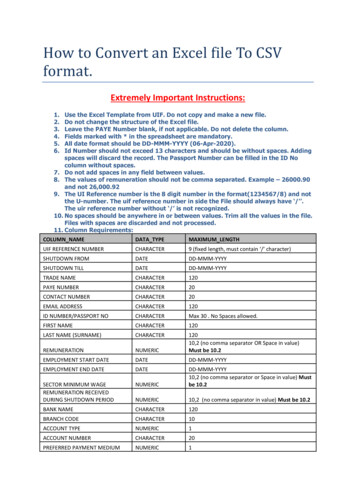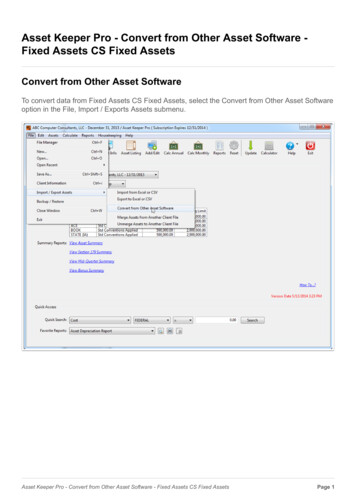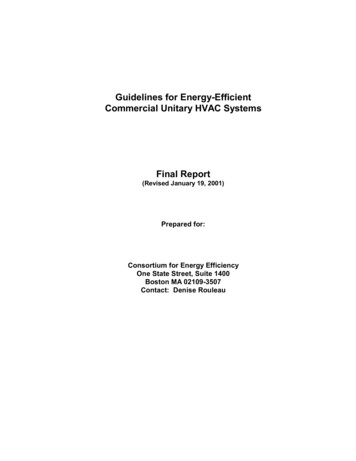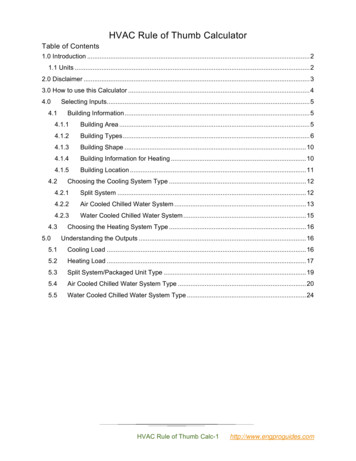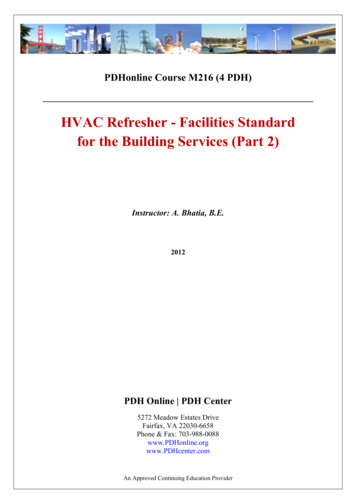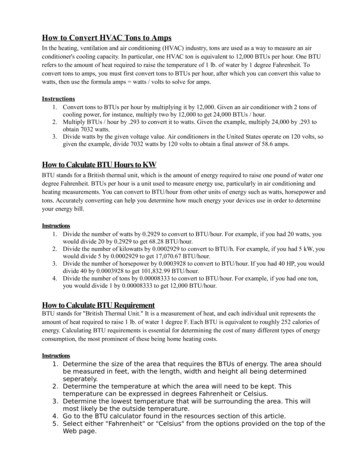
Transcription
How to Convert HVAC Tons to AmpsIn the heating, ventilation and air conditioning (HVAC) industry, tons are used as a way to measure an airconditioner's cooling capacity. In particular, one HVAC ton is equivalent to 12,000 BTUs per hour. One BTUrefers to the amount of heat required to raise the temperature of 1 lb. of water by 1 degree Fahrenheit. Toconvert tons to amps, you must first convert tons to BTUs per hour, after which you can convert this value towatts, then use the formula amps watts / volts to solve for amps.Instructions1. Convert tons to BTUs per hour by multiplying it by 12,000. Given an air conditioner with 2 tons ofcooling power, for instance, multiply two by 12,000 to get 24,000 BTUs / hour.2. Multiply BTUs / hour by .293 to convert it to watts. Given the example, multiply 24,000 by .293 toobtain 7032 watts.3. Divide watts by the given voltage value. Air conditioners in the United States operate on 120 volts, sogiven the example, divide 7032 watts by 120 volts to obtain a final answer of 58.6 amps.How to Calculate BTU Hours to KWBTU stands for a British thermal unit, which is the amount of energy required to raise one pound of water onedegree Fahrenheit. BTUs per hour is a unit used to measure energy use, particularly in air conditioning andheating measurements. You can convert to BTU/hour from other units of energy such as watts, horsepower andtons. Accurately converting can help you determine how much energy your devices use in order to determineyour energy bill.Instructions1. Divide the number of watts by 0.2929 to convert to BTU/hour. For example, if you had 20 watts, youwould divide 20 by 0.2929 to get 68.28 BTU/hour.2. Divide the number of kilowatts by 0.0002929 to convert to BTU/h. For example, if you had 5 kW, youwould divide 5 by 0.0002929 to get 17,070.67 BTU/hour.3. Divide the number of horsepower by 0.0003928 to convert to BTU/hour. If you had 40 HP, you woulddivide 40 by 0.0003928 to get 101,832.99 BTU/hour.4. Divide the number of tons by 0.00008333 to convert to BTU/hour. For example, if you had one ton,you would divide 1 by 0.00008333 to get 12,000 BTU/hour.How to Calculate BTU RequirementBTU stands for "British Thermal Unit." It is a measurement of heat, and each individual unit represents theamount of heat required to raise 1 lb. of water 1 degree F. Each BTU is equivalent to roughly 252 calories ofenergy. Calculating BTU requirements is essential for determining the cost of many different types of energyconsumption, the most prominent of these being home heating costs.Instructions1. Determine the size of the area that requires the BTUs of energy. The area shouldbe measured in feet, with the length, width and height all being determinedseperately.2. Determine the temperature at which the area will need to be kept. Thistemperature can be expressed in degrees Fahrenheit or Celsius.3. Determine the lowest temperature that will be surrounding the area. This willmost likely be the outside temperature.4. Go to the BTU calculator found in the resources section of this article.5. Select either "Fahrenheit" or "Celsius" from the options provided on the top of theWeb page.
6. Enter the data gathered from Steps 1 through 3 into the appropriate fields on theWeb page. Click "calculate."How to Calculate BTU for HeatMetals take less energy to heat than water does.The British thermal unit (Btu) is the heat needed to raise the temperature of a pound of water by a Fahrenheitdegree. Other substances, however, absorb heat at different rates, with each having their own specific heatcapacity. You can use Btus to calculate their heat requirements as well, but you must take into account theirheat capacities and masses.Instructions1. Subtract the substance's current temperature from the temperature you want itto reach. If, for instance, the substance is currently at 22 degrees Celsius, andyou want to heat it to 31 degrees Celsius: 31 - 22 9 degrees.2. Multiply this temperature rise by the substance's specific heat capacity. For a listof specific heat capacities, see the first link in "Resources." If, for instance, youare heating copper, which has a heat capacity of 0.386: 9 x 0.386 3.474.3. Multiply the answer by the substance's weight, measured in grams. If it weighs,for instance, 1,500 grams: 3.474 x 1,500 5,211. This is the heat requirement,measured in joules.4. Divide this answer by 1,055, the number of joules in a Btu: 5,211 1,055 4.94,or approximately 5. The substance needs 5 Btus for you to heat it to 31 degrees.BTU Load CalculationKnowing how powerful an air conditioner or furnace you need is one of the most important factors whenshopping for a new HVAC -- heating, ventilation and air conditioning -- system. The BTU load, ortemperature-change requirements, of your living space must be taken into account for effective airconditioning or heating. Without this knowledge, any such appliance you purchase is likely to be eitherinsufficient or inefficient.BTU LoadsA living area's BTU load is the number of BTUs required to heat or cool it. BTU is the usual abbreviation forBritish thermal unit, a unit of heat energy used to measure the heating and cooling capabilities of airconditioners and furnaces. An appliance that closely matches your BTU load will provide the best service.Why Load Calculation is ImportantKnowing your home or office's BTU load is a must when purchasing a new heater or air conditioner. Anappliance with a rating much below the load level would have a hard time keeping the temperatures at ideallevels. An overly powerful air conditioner, however, can have equally detrimental effects, short-cycling bycooling the room too rapidly and then shutting off. This doesn't give the AC time to dehumidify the roomproperly, leaving too much moisture in the air. A furnace that is too powerful will also burn fuel inefficientlyand cause excess pollution.Manual CalculationA living area's BTU load can be roughly calculated using simple mathematical formulae. Multiply the squarefootage of the room by 31.25 to find the area BTU load. Multiply the square footage of any northward-facingwindows by 15.24 and those of other windows by 80.64, multiplying the product of this equation by 1.4 if thewindows are unshaded to find the total window BTU load. Multiply the usual number of occupants by 600 tofind the occupant BTU load. Finally, multiply the wattage of any office equipment by 3.4 and that of all light
fixtures by 4.25 to find their BTU loads. Add all five numbers to calculate the total BTU load of the room orbuilding.Other Means of CalculationIf math isn't your strong suit, you can just as easily find the BTU load by other means. Consumer Reportsprovides an online tool that takes even more variables into account than the manual calculation, but automatesthe actual computation, giving you more accurate results for less work. Other similar websites also exist. Formost accurate results, however, hire an air conditioning or heating professional to determine the exact BTUload of your home or office.How to Calculate Heating LoadHeat loading involves measuring and evaluating all of the heat sources that contribute to the temperature in aroom or office. Many sources apply, including the sun, equipment running, lights and body heat fromoccupants. For homes, solar radiation from the sun is by far the biggest source as the sun bears down onthe roof and walls. To this end, to calculate heat loading, you need to calculate the contribution fromeach source and add them together. You can then use the information to determine the size and rating ofthe air conditioning unit you need to cool the room or home.Instructions1. Calculate the Area BTU using the formula: Area BTU length (ft.) x width (ft.) x31.252. Calculate the heat contribution from the solar heat radiating through windows.For the north facing windows, use the formula: North Window BTU Area of Northfacing windows x 164. Find the area of each window by multiplying the length bythe width. Add the areas of all north facing windows together and multiply by164. If the north facing windows have no shading, multiply the final value by 1.4.For the south facing windows use the formula: South Window BTU Area ofSouth facing windows x 868. Follow the same procedures as with the north facingwindows, except multiply the total area by 868 followed by 1.4 if no shading. TheTotal Window BTU will be the sum of the North Windows BTU and the SouthWindow BTU.3. Determine the number of occupants that normally occupy the space. Calculatethe Occupant BTU using the formula: Occupant BTU number of occupants x 6004. Locate all of the equipment and appliances that occupy that space such ascomputers, printers, appliances, etc. Refer to the manufacturers tags and find thepower in watts for each item. Add the power of all items together and multiply by3.4 for the total Equipment BTU.5. Find the contribution by the lights in the room or space using the formula:Lighting BTU total lighting watts x 4.25.6. Calculate the Total Heat Load BTU using the formula: Total Heat Load BTU AreaBTU Total Window BTU Occupant BTU Equipment BTU Lighting BTU.How to Calculate a Gas Furnace SizeFinding the appropriate size furnace is important. A furnace that is too small won't be able to heat the areaeffectively, and a furnace that is too large will short-cycle, causing it to turn off and on more often, which willuse unnecessary energy and cost you money. There is a fairly simple way to size a gas furnace. Though it is not100 percent accurate, it will provide a helpful guide for purchasing one.Instructions1. Determine the amount of output BTU (British Thermal Units) you need to heat thearea; output BTU is a measure of the amount of heat the furnace produces. As a
general rule, start with about 30 to 35 output BTUs per square foot; however, thiscan vary depending on climate and how well insulated the area is.2. Now you need to know how to find the output BTU of a furnace. Generally,furnaces will have a list of product specifications. The trick is that many will listinput BTU instead of output BTU to make it seem like they are better than theyreally are. Luckily, they are also required to list efficiency. So, if a furnace doesn'tlist its output BTU, locate its efficiency rating and its input BTU.3. Multiply the furnace's input BTU by its efficiency. For example, if you were lookingat a furnace specification list, and its listed efficiency is 85 percent, and its inputBTU is 100,000. You would multiply 100,000 by .85 to get 85,000. This is theamount of output BTU the furnace has.4. Compare the furnace's output BTU to the amount of BTU you need for the area. Itis fine to have a difference of 10 to 15 percent, but any more than that and youwill either be getting too large a furnace or too small a furnace.How to Calculate KW Capacity of a Water ChillerA chiller's cooling capacity depends on the rate at which it pumps water and the extent to which it reduces thewater's temperature. Calculating the machine's capacity also takes into account water's specific heat capacityand other conversion factors, producing the machine's power in British Thermal Units (BTUs) per hour. Afurther conversion step can convert this value to tons, a common unit of power when describing heating andcooling devices. You can instead convert your result to a more standard unit of power -- the kilowatt.Instructions1. Subtract the temperature of water entering the chiller from that of water leavingit. If water enters the chiller at 63 degrees Fahrenheit and leaves at 49: 63 - 49 14 degrees.2. Multiply the result by the chiller's volumetric flow rate, measured in gallons perminute (gpm). If 230 gallons of water move through the chiller per minute: 14 x230 3,220.3. Multiply the answer by 500, finding the chiller's capacity in BTUs per hour: 3,220x 500 1,610,000.4. Divide your answer by 3,412 to convert your answer to kilowatts: 1,610,000 /3,412 472 kW.How to Calculate Ton Capacity of ChillersA chiller uses a refrigeration cycle to cool water. This chilled water then cools a larger area, such as a factoryfloor. Cooling equipment in this matter increases its efficiency by providing a steady thermal environment. Youcan derive a chiller's capacity from the temperature drop it creates and the volumetric flow of the water withinit. This formula produces the chiller's capacity in British Thermal Units (BTUs). That scale directlycorresponds with the more common unit of "tons" that cooling systems often use.Instructions1. Subtract the temperature of water as its leaves the chiller from the temperatureof the water as it enters it. If water enters the chiller at 64 degrees Fahrenheitand leaves at 51 degrees Fahrenheit: 64 - 51 13 degrees.2. Multiply the result by your flow rate, which is measured in gallons per minute. If,for instance, the chiller must move 300 gallons per minute: 13 x 300 3,900gallons per minute.3. Multiply your answer by 500. This converts the volumetric flow rate to a massflow rate, which is measured in pounds of water per hour. With this example:
3,900 x 500 1,950,000. This answer is the chiller's capacity measured in BTUsper hour.4. Divide your answer by 12,000: 1,950,000 / 12,000 162.5. This is the chiller'scapacity in tons.How to Figure GPM Water Flow on an Existing ChillerTechnicians calculate a chiller's volumetric flow rate similarly to how they find the flow rate in other pumpsystems. As with other systems, a chiller's flow rate depends on the chiller's pressure and the system's overallefficiency. This pressure is typically measured in terms of total dynamic head, a figure that considers the fluid'sstatic pressure, the pressure the pump adds and pressure losses due to friction.Instructions1. Multiply the fluid's horsepower by 3960. If the chiller works at 25 horsepower: 25x 3960 99,000.2. Multiply your answer by the pump's efficiency. If the pump works at 80 percentefficiency: 99,000 x 0.80
2. Divide the number of kilowatts by 0.0002929 to convert to BTU/h. For example, if you had 5 kW, you would divide 5 by 0.0002929 to get 17,070.67 BTU/hour. 3. Divide the number of horsepower by 0.0003928 to convert to BTU/hour. If you had 40 HP, you would divide 40 by 0.0003928 to get 101,832.99 BTU/hour. 4. Divide the number of tons by 0.00008333 to convert to BTU/hour. For example, if you File Size: 534KBPage Count: 33
